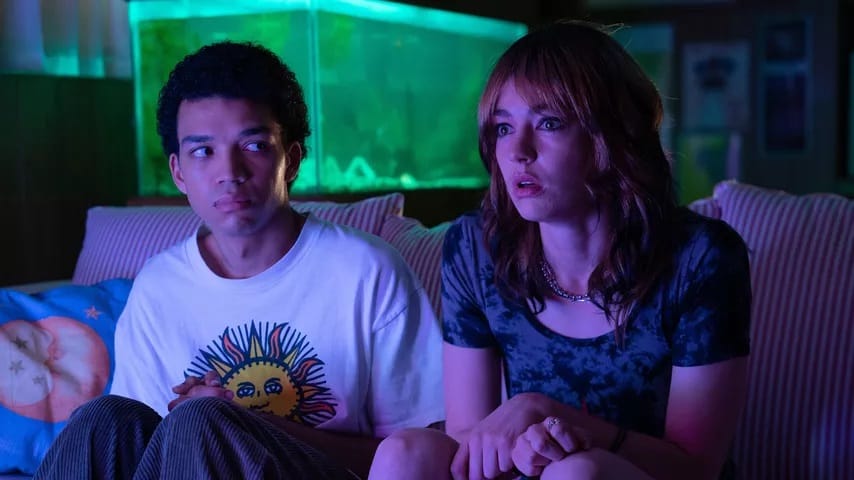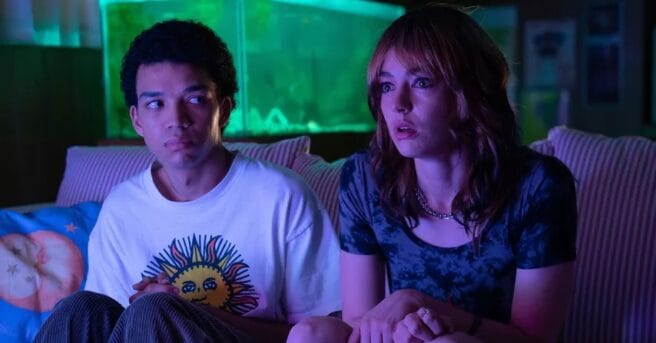
I Saw the TV Glow is ambitious, surreal and experimental – perhaps too much so as it occasionally, becomes tedious to watch.
PLOT: An awkward teen (Justice Smith) and his friend (Brigette Lundy-Paine) become obsessed with a teen drama called The Pink Opaque. But, years after it gets cancelled, the lines between reality and fiction start to blur as they begin to wonder if perhaps they are part of the show they love.
REVIEW: I Saw the TV Glow seems bound to be a conversation starter for horror fans once A24 puts it out later this year. By design, it’s a movie that’s meant to be dissected, with it defying genre expectations to the point that, for some folks, this will be a genuinely tedious experience. At the same time, others will love director Jane Schoenbrun’s stab at what the Sundance programmers have called “emo-horror.”
I’m sorry to say that I found this a difficult sit, as within ten minutes, I was looking at my watch and realizing that I was in for a bit of a long haul. I like elevated horror as much as the next person, but this is so experimental that it feels like a half-baked attempt at a genre version of Inland Empire-era David Lynch.
Essentially an allegorical tale examining, among other things, trans identity, the film revolves around a misfit teen who is drawn to an older girl at his school who turns him on to a cheap and cheesy Nickelodeon-style Buffy rip-off called The Pink Opaque. Both become obsessed with the show, but as time and reality start to blur, with years going by like minutes, they begin to wonder whether or not they might actually be a part of the show. Schoenbrun never spells out whether this is real or just something in their heads, but it’s a surreal headtrip of a movie, anchored by two earnest performances.
While the nearly thirty-year-old leads, Justice Smith and Brigette Lundy-Paine (Bill & Ted Face the Music), initially seem ludicrously cast as ninth graders, Schoenbrun’s choice makes more sense as the film progresses. One cannot fault the acting, with both leads throwing themselves into complex parts, but Schoenbrun also seems hellbent on defying any expectations relating to the genre. As such, it’s a horror movie without any horror. Highly experimental and much more an art film than the early buzz suggests (it’s a little too obtuse to work in the Sundance Midnight section and would have been better served in the experimental NEXT section), I can see this splitting audiences significantly. It seems bound to be the type of movie that tops both “best of” and “worst of” lists at the end of the year, and one has to give Schoenbrun credit for being true to their own voice – even if – again, I’ll freely admit that I didn’t “get it.”

But, while I was shifting in my seat and looking at my watch more than I expected here, I’ll admit there are elements of the film that work. Visually, it’s pretty stunning, with it set in the nineties-2000s and embracing a retro aesthetic that bathes the film in rich neons. The score by lo-fi artist Alex G is also highly effective, with the film even stopping for a few rather well-shot musical numbers that give the movie a sometimes pleasant dreamlike aesthetic. One also can’t fault Smith or Lundy-Paine, although the great Danielle Deadwyler was wasted in a throwaway role as Smith’s mother. The recreations of nineties-era tween shows like Are You Afraid of the Dark are also amusingly done.
If anything, I’ll admit that I Saw the TV Glow might be ripe for revisiting. As much as I disliked the experience of watching this, I couldn’t help but wonder what I might have thought if I had my trusty weed vape nearby and was maybe nibbling on a magic mushroom or two. As such, this (pretty negative) review comes with the caveat that if I end up watching the film again, with perhaps the help of some modest psychedelics, I might change my mind about it.
Originally published at https://www.joblo.com/i-saw-the-tv-glow-sundance-review/
